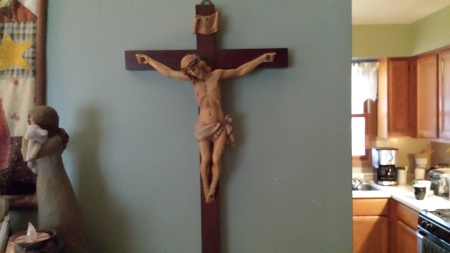“Mankind will not have peace until it turns to the fount of My Mercy.” – Diary of Saint Maria Faustina Kowalska, 699.
In 1931, Jesus began appearing as the “King of Divine Mercy” to a young, poor, minimally educated Polish nun. Sister Maria Faustina Kowalska, urged by her confessor, Father Michael Sopoćko, began writing a diary to record her conversations with and messages from Jesus.
While at a dance with her sister, 19-year-old Helena Kowalska received a vision of Jesus, suffering. Shortly after that, Jesus urged her to enter a convent. She eventually did, in Warsaw at age 20. It was 1926. For the rest of her short life (she died at age 33), Sister Faustina — as she was now known — dutifully recorded the Lord’s instructions. She is also sometimes referred to as the Secretary of Divine Mercy.
On Good Friday, 1937, Jesus gave Sister Faustina instructions for the Novena of Divine Mercy. The nine days of prayer were to begin on Good Friday and continue until Divine Mercy Sunday, the Second Sunday of Easter, per the Lord’s instructions.
Much has been written about Sister Faustina, the revelations, her psychiatric and physical examination to determine that she was of sound mind, the Church’s examination of her diary for theological accuracy, and the biography of her life. When I first discovered the Chaplet of Divine Mercy, my life and my perspective changed. It’s difficult to explain without sounding or appearing irrational, but I will say this: Thomas Aquinas argued that both philosophy and science lead to truth. Father Wade Menezes, of the Fathers of Mercy, concisely explains that faith and reason do not oppose one another and are actually harmonious.
“Faith and reason are like two wings on which the human spirit rises to the contemplation of truth.” – St. Pope John Paul II
I’m going to leave the discussion there for now, but will expand on it at a later time. For now, I posit that it is reasonable to conclude that Faustina was speaking for Christ.
Jesus told Faustina
“My daughter, if I demand through you that people revere My mercy, you should be the first to distinguish yourself by this confidence in My mercy. I demand from you deeds of mercy, which are to arise out of love for Me. You are to show mercy to your neighbors always and everywhere. You must not shrink from this or try to excuse or absolve yourself from it.
I am giving you three ways of exercising mercy toward your neighbor: the first – by deed, the second – by word, the third – by prayer. In these three degrees is contained the fullness of mercy, and it is an unquestionable proof of love for Me. By this means a soul glorifies and pays reverence to My mercy. Yes, the first Sunday after Easter is the Feast of Mercy, but there must also be acts of mercy, and I demand the worship of My mercy through the solemn celebration of the Feast and through the veneration of the image which is painted. By means of this image I shall grant many graces to souls. It is to be a reminder of the demands of My mercy, because even the strongest faith is of no avail without works.” (Diary, 742)
And on the Divine Mercy Novena:
“I desire that during these nine days you bring souls to the fountain of My mercy, that they may draw therefrom strength and refreshment and whatever grace they need in the hardships of life, and especially at the hour of death.” – Diary of Saint Maria Faustina Kowalska, 1209.
Jesus instructed that we pray for a different group of souls each day of the Novena. Pages for each day of the Novena follow.

How to pray the Chaplet: http://www.thedivinemercy.org/message/devotions/praythechaplet.php
Novena Pages:
Novena to The Divine Mercy – Day One
[…] Divine Mercy […]
LikeLike
[…] Divine Mercy […]
LikeLike
[…] Divine Mercy […]
LikeLike
[…] Divine Mercy […]
LikeLike
[…] Divine Mercy […]
LikeLike
[…] Divine Mercy […]
LikeLike
[…] Divine Mercy […]
LikeLike
[…] Divine Mercy […]
LikeLike